Human rabies post-exposure prophylaxis: a review of the treatment of accidents involving domestic cats
DOI :
https://doi.org/10.21708/avb.2022.16.3.10825Résumé
Rabies is an anthropozoonosis that presents approximately 100% lethality and expensive preventive assistance. Many human post-exposure anti-rabies treatments indicated for people at risk of exposure to rabies virus, usually due to some aggression by a mammalian animal, are instituted annually. This study aimed to evaluate the initial care of post-exposure prophylaxis of human rabies in Belo Horizonte between 2007 and 2016, involving accidents with domestic cats. It was found 71.1% agreement between the treatments instituted by health services and the protocol of the Ministry of Health. Treatments classified as insufficient totaled 18.3% and excessive, 10.6%. The animals were healthy in 68% and observable in 68.4% of the cases. Treatments involving the use of anti-rabies vaccine totaled 87.7%. The most frequent treatment adopted by the health services was observing the animals associated with the human anti-rabies vaccination in 56.7% of the cases. Imperfections in the filling of the notifications must be revised to enable improvements for future analyses. As for human prophylactic anti-rabies care, forming a multidisciplinary health team including veterinarians would be well on the way to improving the service offered.
Téléchargements

Téléchargements
Publié-e
Numéro
Rubrique
Licence
(c) Tous droits réservés Acta Veterinaria Brasilica 2022

Cette œuvre est sous licence Creative Commons Attribution 4.0 International.
Autores que publicam na Acta Veterinaria Brasilica concordam com os seguintes termos: a) Autores mantém os direitos autorais e concedem à revista o direito de primeira publicação, com o trabalho simultaneamente licenciado sob a Licença Creative Commons Attribution que permite o compartilhamento do trabalho com reconhecimento da autoria e publicação inicial nesta revista. b) Autores têm autorização para assumir contratos adicionais separadamente, para distribuição não-exclusiva da versão do trabalho publicada nesta revista (ex.: publicar em repositório institucional ou como capítulo de livro), com reconhecimento de autoria e publicação inicial nesta revista. c) Autores têm permissão e são estimulados a publicar e distribuir seu trabalho online (ex.: em repositórios institucionais ou na sua página pessoal) a qualquer ponto antes ou durante o processo editorial, já que isso pode gerar alterações produtivas, bem como aumentar o impacto e a citação do trabalho publicado (Veja O Efeito do Acesso Livre).


 Esta obra está licenciada com uma Licença
Esta obra está licenciada com uma Licença 